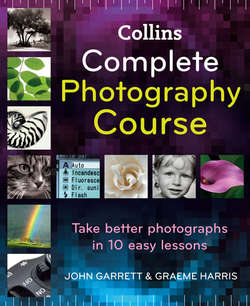Читать книгу Collins Complete Photography Course - John Garrett, Graeme Harris - Страница 4
Introduction
ОглавлениеThis book assumes no previous knowledge of photography, though it is intended not only for beginners but also for those who have some experience and are looking for inspiration to take them on to the next level.
After an initial discussion of the equipment you are most likely to have or to acquire, the book is divided into lessons. Each includes a series of projects which are progressive, leading you from the most elementary information right through to more complicated assignments.
Your camera can be film or digital – the images in this book have been shot on both types of camera and the information is equally valid for both systems. However, it largely applies to SLR or DSLR cameras, as that is what a large number of people use for their photography today.
The thrust of the book is very definitely a creative one; it is not a techy book aimed at those photographers who like spending their time swapping the names of the newest camera models or attempting to obtain batteries from the same batch to ensure success.
Rather, it is written for people who would love to improve their photography without getting bogged down in page after page of technical information – stuff we don’t believe is necessary, and which in fact often gets in the way, since worrying about it can act as a brake on your creativity and imagination. It is also designed to be a companion to students doing a formal photographic course.
Too much information
In retrospect, we both realize that we had trouble learning from the textbooks that we read when we studied photography at college. They were too dry and too heavily weighted towards technical information. Even today’s textbooks, although more accessible, can still leave a beginner in a state of confusion.
We became aware that we could have saved ourselves considerable time and frustration in our earlier years if we had had access to a book that would lead us through progressive steps without bogging us down in reams of technical jargon, from which vital information had to be painstakingly extracted. With this in mind, we have distilled what we feel to be the most important basic steps for improving your photography quickly.
The learning process
This book aims to teach you the techniques that experience has shown us are the essence of photography, stressing that any technical decision is also a creative one.
The purpose of the projects is to cement the information in your mind by asking you to have a go for yourself. Our aim is that you will shoot examples that are based on the projects, using our pictures as a visual guide. Throughout, we are on your side, encouraging you to find the creative muse that lives inside us all.
You will contribute a great deal to the learning process if you complete the projects, as you can discover far more about photography by doing it rather than just reading about it. So pick up your camera, set out with confidence and a keen eye for an image and you will find that your photography really begins to take off.
In this close-up picture of a rose, the structure of the centre petals has a similar look to the diaphragm blades of the iris in a lens – irresistible for a photographer. GH
